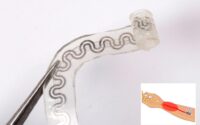Cancer survivor describes how femfit fixed her leaky bladder
Australian mom Renee Brown was just 39 when she had surgery to remove cancerous lymph nodes from her pelvis.
Then, she underwent chemotherapy and radiation therapy as part of her cervical cancer battle.
After the treatments, she faced a new challenge — urinary incontinence.
“It was often far more than a dribble, and it was happening through the day,” Brown, from Victoria, told Jam Press.
“I frequently couldn’t even make it to the toilet when I woke up,” she recalled. “It was incredibly debilitating.”
Now, Brown has taken her life back — thanks to a thin device called Femfit that she wears to strengthen her pelvic floor.
The American Cancer Society predicted that nearly 14,000 new cases of invasive cervical cancer would be diagnosed in 2023, and 4,300 women would die from the disease.
HPV vaccines and Pap tests have helped lower the cervical cancer death rate by identifying cervix changes before cancer develops or progresses.
For her part, Brown was diagnosed with cervical cancer in 2019.
To ease her resulting incontinence, she tried patches designed to treat an overactive bladder and an electromagnetic pad chair to strengthen her pelvic floor muscles.
A healthy pelvic floor can help prevent bladder leakage.
Brown, a mom of one, decided the chair was not practical for the long term because she had developed brittle bones from osteopenia caused by the radiation therapy.
By chance, she spotted a bulletin from Counterpart, a female-led cancer counseling organization seeking participants for a study at the University of Melbourne.
The research team recommended Brown try Femfit, which was only available in Australia and New Zealand at the time.
“The difference is like night and day,” Brown enthused. “I could actually feel not only that change when using the Femfit [device and] app, but the change actually happening physically. I ended up having more control so that I could make it to the toilet in the morning.”
Femfit is inserted into the vagina for the duration of a pelvic floor exercise session — typically just 10 minutes.
Eight pressure sensors on the device determine if the exercises are being performed correctly.
Feedback is transmitted to the Femfit app on the user’s smartphone, and women are also given access to remote telehealth sessions with research physiotherapists.
Junofem — creators of Femfit — noted that without guidance, many women struggle to nail the proper technique for pelvic floor exercises.
“I didn’t realize until I started using the device that I was good at contracting my pelvic floor,” Brown explained.
“But I was no good at relaxing between squeezing, and that exercise really brought this to life,” she added.
Femfit is available over the counter for around $265 — for use at home or in a health care clinic — and it can be utilized while lying down, sitting or standing.
“Struggling with urinary incontinence, as a consequence of treatment for gynecological cancer, is common,” said Jenny Kruger of Junofem. “Providing means or ways of assisting women to regain control over parts of their lives that have been hugely impacted is of immense importance.”
The 12-week “Strength Builder” program is said to resolve up to 80% of urinary incontinence symptoms.
Users have reported dramatic improvements in incontinence issues after giving birth and while going through menopause.
Obstetrician and gynecologist Jackie Smalldridge said: “Urinary incontinence is a common condition typically experienced by 1 in 3 women. One of our goals is to educate women that effective pelvic floor exercising can make a huge difference.”


